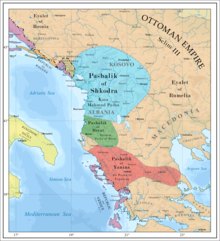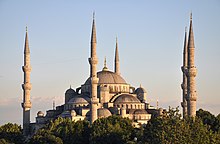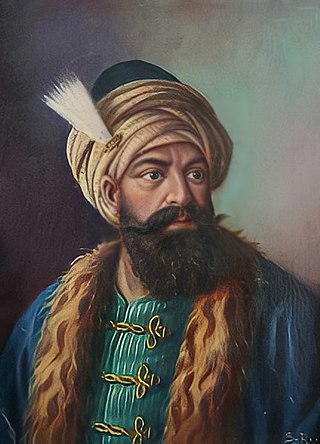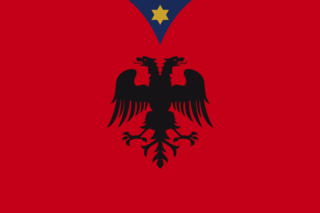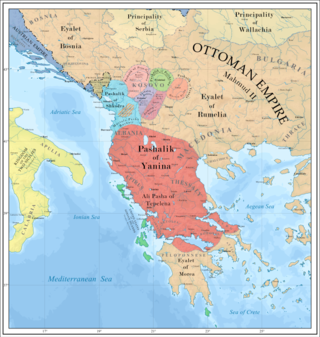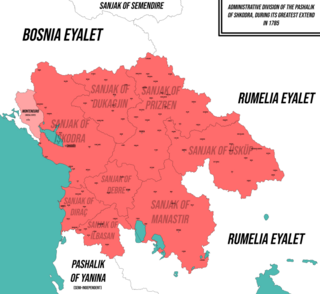This article needs additional citations for verification .(October 2023) |
Ottoman Albania | |
|---|---|
| 1479–1912 | |
1) Location of Ottoman Albania, Map commissioned by Pope Clement XI after funding an expedition in Albania to locate his family's origins. 2) Map of the Albanian Vilayet. | |
| Common languages | Albanian |
| Religion | Sunni Islam (official) Christianity (Eastern Orthodox, Roman Catholicism) |
| Demonym(s) | Arnaut (ارناود) |
| Government | |
| Beylerbey, Pasha, Agha, Dey | |
| History | |
| 1479 | |
| 1912 | |
| Today part of | Albania |
| History of Albania |
|---|
 |
| Timeline |
Ottoman Albania refers to a period in Albanian history from the Ottoman conquest in the late 15th century to the Albanian declaration of Independence and official secession from the Ottoman Empire in 1912. The Ottomans first entered Albania in 1385 upon the invitation of the Albanian noble Karl Thopia to suppress the forces of the noble Balša II during the battle of Savra. They had some previous influence in some Albanian regions after the battle of Savra in 1385 but not direct control. The Ottomans placed garrisons throughout southern Albania by 1420s and established formal jurisdiction in central Albania by 1431. Even though The Ottomans claimed rule of all Albanian lands, most Albanian ethnic territories were still governed by medieval Albanian nobility who were free of Ottoman rule. The Sanjak of Albania was established in 1420 or 1430 controlling mostly central Albania, while Ottoman rule became more consolidated in 1481, after the fall of Shkodra and League of Lezhe with the country (including areas of today's Kosovo, Montenegro and Macedonia) being mostly free in the period of 1443–1481. Albanians revolted again in 1481 but the Ottomans finally controlled Albania by 1488.
Contents
- History
- 14th century
- 16th–17th centuries
- 18th–19th centuries and the Albanian Pashaliks
- 20th century
- Governance
- Administrative divisions
- Taxation
- Culture
- Religion
- See also
- References
- Bibliography
The term used in Ottoman sources for the country was Arnavudluk (Ottoman Turkish: آرناوودلق), including areas such as present-day Albania, Kosovo, western North Macedonia, southern Serbia, southern Montenegro and parts of northern Greece. [1] [2]
In 1431, Many Albanian princes including Gjergj Arianiti, Zenevisi family, Andrea Thopia and Gjon Kastrioti started a war against the Ottoman Empire which resulted in defeat of Gjon Kastrioti but victory in 4 battles for Gjergj Arianiti and 1 victory for Andrea Thopia. These Albanian victories opened the way for the coming of Skanderbeg in 1443 in Kruja. Independence for most of the Albanian regions was maintained during 1443–1479, with the uprising under the lead of Skanderbeg that together with other Albanian nobles such Gjergj Arianiti, Andrea Thopia and Lek Dukagjini achieved remarkable result of 30+ victories against the Ottoman Empire. [3]
The Albanian resistance and war against Ottomans continued for 48 years. The last towns captured by the Ottomans were Shkodër in 1480, Durrës in 1501 and Himara in 1509, except for the northern part of Albania, Mirdita, which could never be fully invaded. The Ottomans seeing the impossibility to invade this place they were forced to ensure the region the right of autonomy with its own heredity princes. [4] Principality of Mirdita remained always free which was ruled by the Gjomarka family for 400 years essentially throughout the entire Ottoman period in the Balkans. [5]
Albanians would enter later on in a period of Islamization, starting in the late 14th century and early 15th century, and increasing especially in the 16th and 17th centuries. Albanians through converting to Islam would eventually dominate the Ottoman power structures disproportionally to their small population considering the large territory and huge population of the Ottoman Empire. They would become one of the most important and prestigious nations in the Empire playing an important role in the 15th and 16th centuries and especially a striking role in the 17th,18th and 19th centuries.
A period of the semi-independence started for local Albanian rulers in Balkans in the 1750s with the era of the so called Independent Albanian Pashas. In 1754 the autonomous Albanian Pashalik of Bushati family would be established with center the city of Shkodra called Pashalik of Shkodra. Later on the same autonomous Pashalik of Berat would be established and culminating with the Albanian Pashalik of Ali Pashe Tepelena in 1787. The Albanian Pashaliks would end in 1831 with the last one being the Bushati Pashalik. These de facto independent Albanian Pashaliks would extend from Bosnia to south of Morea ( Peloponnese) in today's southern Greece.
Meanwhile, an Ottoman Albanian commander Mehmet Ali of Egypt, would seize power in Egypt in 1805 through his Albanian mercenaries by establishing a dynasty lasting up to 1954. He would take over Sudan and many regions of Saudi Arabia by 1824 and would take over Levant later on in 1831 by even defeating Ottomans in 1833. The conflict would rise again in what is known as Egyptian-Ottoman War (1839-1841) and only European Powers would stop Mehmet Ali and his son Ibrahim Pasha to seize Constantinople and replace the Ottoman dynasty with the Albanian one by thus resolving the Oriental Crisis of 1840. Albanian communities exist up to this day in Egypt and other areas of Levant such as Syria and Palestine.
The territory which today belongs to the Republic of Albania remained part of the Ottoman Empire until it declared independence in 1912, during the Balkan Wars.





